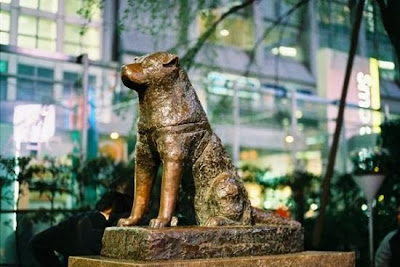Hachi: A Dog's Tale is a 2009 drama film based on the true story of a faithful Akita Inu, the titular Hachikō. It is a remake of the 1987 film Hachi-kō (ハチ公物語, literally "The Tale of Hachiko"). It was directed by Lasse Hallström, written by Stephen P. Lindsey and stars Richard Gere, Joan Allen, and Sarah Roemer.
The first foreign premiere was on August 8, 2009, in Japan.
A spiritual reading of the true story of a love dog.
The Real Story
The real Hachi was born in Odate, Japan, in 1923, and lived with a
professor at Tokyo University. Every day the dog would accompany Dr.
Ueno to the train station where he left for work; the dog would return
at the end of the day to meet him. But one day Dr. Ueno had a stroke
while teaching and died. For the next nine years, Hachi returned to the
Shibuya train station where he last saw his friend.
A bronze statue now sits in the place where the dog waited. His story
has been told and retold to Japanese children as an example of family
loyalty and the importance of being true to the memory of a loved one.
The DVD includes a short film titled "A Bond of Loyalty: The Making of
Hachi: A Dog's Tale" in which the stars and director share other
examples of Hachi's enduring legacy.
Love Dog
Hachi's story is a beautiful testimony to loyalty, patience, and
friendship. But it can also be seen from a spiritual perspective as a
parable about the spiritual practice of yearning as a way we stay
connected with the Divine.
We identify with Hachi and feel compassion for him, especially in his
later years, because we, too, know what it means to be separated from
our Beloved. He remembers what it was like to be in constant communion
with his beloved. How can he have that again? How can we have that
again? By showing up day after day in love and devotion. Rumi would call
Hachi a "Love Dog."
One night a man was crying.
Allah! Allah!
His lips grew sweet with the praising,
until a cynic said,
“So! I have heard you
calling out, but have you ever
gotten any response?”
The man had no answer to that.
He quit praying and fell into a confused sleep.
He dreamed he saw Khidr, the guide of souls,
in a thick, green foliage.
“Why did you stop praising?”
“This longing
you express is the return message.”
The grief you cry out from
draws you toward union.
Your pure sadness
that wants help
is the secret cup.
Listen to the moan of a dog for its master.
That whining is the connection.
There are love dogs
no one knows the names of.
Give your life
to be one of them.
— Jelaluddin Rumi, translation by Coleman Barks
Movie here:
http://megashare.info/watch-hachiko-a-dogs-story-online-TXpNNU1BPT0
The film score of Hachi: A Dog's Tale was composed by Jan A. P. Kaczmarek.
full album here :
Hachiko: A Dog's Story Album by Jan A.P. Kaczmarek
- "Japan" (03:26)
- "New Home" (01:47)
- "The Foot" (02:40)
- "Dance Rehearsal" (02:15)
- "Storm and the Rescue" (01:36)
- "The Second Dance" (00:51)
- "Under the Fence" (01:51)
- "Treats from Cate" (01:52)
- "Parker's Dance Played on Piano" (03:42)
- "Parker and Hachi Walk to the Station" (02:04)
- "Baby" (01:23)
- "Marriage Bath" (03:27)
- "Fetch" (02:12)
- "To Train Together" (03:25)
- "Packing Boxes" (02:15)
- "Parker and Hachi" (03:28)
- "Hachiko Runs Away" (04:27)
- "Memory of the Storm" (01:36)
- "Hachi Waiting for Parker Again" (02:51)
- "Hachi's Last Trip to the Station" (02:06)
- "Goodbye" (02:10)
- "Hachi, Parker, Cate and Memories" (03:58)
- "Hachi's Voice (Version 1)" (Bonus track) (00:14)
- "Hachi's Voice (Version 2)" (Bonus track) (00:10)
- "Hachi's Voice (Version 3)" (Bonus track) (00:11)
- "Hachi's Voice (Version 4)" (Bonus track) (00:09)

Hachikō (November 10, 1923 – March 8, 1935). Known in Japanese as
chūken Hachikō - ”Faithful dog Hachikō” ['hachi' meaning 'eight', a
number referring to the dog's birth order in the litter, and 'kō',
meaning prince or duke] .
In 1924, Hidesaburō Ueno, a professor in the agriculture department at the University of Tokyo, took in Hachikō, a golden brown Akita, as a pet. During his owner’s life, Hachikō greeted him at the end of each day at the nearby Shibuya Station. The pair continued their daily routine until May 1925, when Professor Ueno did not return. The professor had suffered from a cerebral hemorrhage and
died, never returning to the train station where Hachikō was waiting.
Every day for the next nine years the dog waited at Shibuya station.
Hachikō attracted the attention of other commuters. Many of the
people who frequented the Shibuya train station had seen Hachikō and
Professor Ueno together each day. Initial reactions from the people,
especially from those working at the station, were not necessarily
friendly. However, after the first appearance of the article about him
on October 4, 1932 in Asahi Shimbun,
people started to bring Hachikō treats and food to nourish him during
his wait. This continued for nine years with Hachikō appearing precisely
when the train was due at the station.
The Demise:
Hachikō died on March 8, 1935, and was found on a street in Shibuya. Hachikō’s stuffed and mounted remains are kept at the National Science Museum of Japan in Ueno, Tokyo. His grave is in Aoyama cemetery in Minatoku, Tokyo.
The Symbol
In April 1934, a bronze statue in his likeness was erected at Shibuya Station.
Later, The new statue was erected in August 1948, still stands and is
an extremely popular meeting spot. The station entrance near this statue
is named “Hachikō-guchi”, meaning “The Hachikō Entrance/Exit”, and is
one of Shibuya Station’s five exits.

























